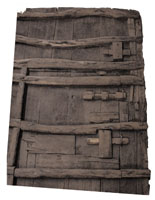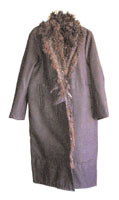
Seven Yemeni handcrafts face extinction (Part 3) [Archives:2008/1130/Culture]
February 18 2008
 |
 |
 |
 |
For Yemen Times
Many traditional Yemeni handcrafts are in great demand due to their elegant style and the high quality of raw materials used. However, many more have disappeared completely or are in danger of losing their identity because each craft demands a set of specialized skills and raw materials of high quality. Because Yemen's raw materials are exported outside the country, their prices have increased.
A December 2007 field study attempting to catalog and document traditional handcrafts in the Old City of Sana'a found that while 28 percent the area's residents are craftsmen, most have discontinued such work for several reasons, most importantly, low income and more cheaply imported similar handcrafts.
A national team from Yemen's General Organization of Antiquities, Museums and Manuscripts, under the auspices of the Social Fund for Development, worked for a year to document all Yemeni handcrafts in the Old City of Sana'a, which are an important part of the nation's cultural heritage created by various civilizations throughout centuries of history. Thus, they are experiences handed down from generation to generation.
The seven-member research team consisted of: Amat Al-Bari Al-Adi, Amat Al-Razzaq Jahaf, Abdulqadir Al-Shaibani, Zaid Al-Faqih, Ibrahim Al-Hadid and Abdulaziz Ibrahim.
Team leader Al-Adi believes that imported handcrafts affect Yemeni handcrafts. According to initial team estimates, Jahaf says only 35 percent of such handcrafts exist today in the Old City, which threatens craftsmen with losing their livelihoods.
Further, because raw materials have become rare, many craftsmen depend on exported raw materials, which affects the quality of the handcrafts.
Al-Adi explained that in order to reach those outcomes, the team conducted its research in four stages, the first of which was a survey to determine the number of handcrafts, craftsmen and handcraft shops. The survey involved the type of handcraft, the number of shops selling it and the name of the street where it's located.
The team leader continued, “Next, we analyzed the results and used them to apply stage two,” which was collecting the historical background of the 27 Yemeni handcrafts.
“Stage three was preparing a meeting of specialists in this field to study what we did and to continue our work of cataloging the handcrafts,” Al-Adi noted. The final stage was a comprehensive field study wherein the team surveyed and documented Old City handcrafts by photographing and recording everything, even the songs the craftsmen sing while they work.
Handcrafts facing extinctio
Out of 27 Yemeni handcrafts, seven are threatened with vanishing. They are: traditional lock making, scale making, blacksmithing, dyeing, tanning, shoemaking and traditional kawafi (hats).
Traditional locks
The main material used to make these locks and their keys is al-tanab wood, which is renowned for its hardness and durability.
“This handcraft developed over time until blacksmiths began making lock parts and keys,” Jahaf noted.
Yahya Al-Soyari, a 42-year-old craftsman and a professional in this handcraft, has worked in this craft since 1976.
Jahaf documented the traditional locks and their keys she found in Al-Soyari's shop, including a lock with an iron handle and another made of wood. Also found were a door lock and two wardrobe locks.
Scales
Like traditional Yemeni locks, most traditional scales (makayeel) also are made from al-tanab wood. Traditional scales were used not only in Sana'a, but in most regions of Yemen, with Al-Adi affirming, “Numerous manuscripts prove that scales were used since the time of Sheba.”
Those who make such scales should be honest, just, righteous and wise due to the fact that their work is extremely sensitive and requires a higher degree of accuracy.
As Al-Adi explained, “There were different types of scales, but the only type remaining by the 1920s was a Sana'ani scale called Al-Zabdi. But nowadays, this type also is no longer in use.”
Blacksmithing
“Because Yemen is an agrarian country, blacksmiths attained a high status,” Al-Adi noted, adding, “Nearly all agricultural implements and tools are made by blacksmiths.”
Moreover, Yemen was famed for its arms industry. Historical resources and documents from the Rasulid state prove that raw iron ore was excavated locally. The most famous is Al-Sa'adi iron taken from Sa'ada. Because of the high quality of this iron, Jahaf said it also was exported to India and Egypt.
At 85, Ahmed Al-Aroosi is considered one of the oldest blacksmiths in the Old City of Sana'a and, according to Jahaf, he can attest to the veracity of the aforementioned information.
Dyeing
“Yemenis used natural resources, such as pomegranate skins, black raisins, hurud (a type of spice made to color food) and even ash, to dye textiles” Al-Adi explained.
“We documented this handcraft with the assistance of the most professional craftsman in the Old City of Sana'a, Ali Al-Milsi, because he's the only one who knows the steps in traditional dyeing.” However, Jahaf explained, he abandoned the craft due to imported maghamiq from India. Al-maghamiq is a piece of fabric used to cover a woman's head. She also may wrap it in such a way as to veil her face.
Tanning
The traditional method and process of tanning has endured for a long time. “According to the study, changes that developed in this handcraft involved some of the materials used, as well as the tools,” Jahaf explained.
Craftsman Yahya Kabee, 53, remarked, “I've been working in this craft for 34 years. Additionally, I make clothing made from the leather that I tan.”
Shoemaking
This is one of the oldest traditional handcrafts due to the large quantity of locally dyed leather. “Many ancient statues before the birth of Christ show them wearing leather shoes,” Jahaf noted.
“Moreover, the shoes of one of the mummies in the museum at Sana'a University's Antiques College are considered a prominent example of accurate and skillful shoemaking in Yemen,” she added.
Al-kawafi, traditional men's head covering
“Most people have abandoned traditional clothing and just wear modern ones,” Jahaf said. One reason is that the exported materials used to make al-kawafi aren't as good as local ones, which are either imported or no longer available.
Al-kawafi are well known in the Tihama as a type of men's head covering. “Most people who wear it are seekers of knowledge, such as those studying Islamic Sharia or those about to receive their academic degrees,” Jahaf explained.
——
[archive-e:1130-v:15-y:2008-d:2008-02-18-p:culture]


